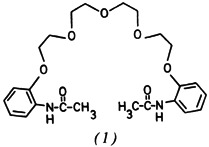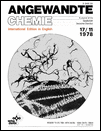Journal list menu
Export Citations
Download PDFs
Graphical Abstract (Angew. Chem. Int. Ed. Engl. 11/1978)
- First Published: November 1978
Reviews
High-Resolution, Higher-Order UV/VIS Derivative Spectrophotometry†
- Pages: 785-799
- First Published: November 1978

The evaluation of UV/VIS spectra is frequently facilitated, and sometimes only becomes possible, on consideration of a higher-order derivative (preferably the 3rd, 4th, or 5th derivative) instead of the original spectrum. With aid of a new analog computer, low-noise on-line derivative spectra can now be obtained up to the 7th (or even 9th) order.
Organometallic Syntheses with Diazoalkanes†
- Pages: 800-812
- First Published: November 1978
Electrostatics, the Chemical Bond and Molecular Stability
- Pages: 812-819
- First Published: November 1978
Polyethylene Fibrids: Preparation and Properties†‡
- Pages: 820-825
- First Published: November 1978
Lise Meitner: Her Life and Times—On the Centenary of the Great Scientist's Birth
- Pages: 826-842
- First Published: November 1978
Lise Meitner (1878–1968) paved the way for the chemical identification of one of the first fission products of uranium by O. Hahn and F. Strassmann in her joint work with those authors on the “transuranics” (1934–1938); and together with O. R. Frisch she provided the first theoretical interpretation of this experimental result (Ba instead of the expected Ra). Her lot was determined by the times in which she lived, and stands as a warning to us all. Newly discovered documents throw fresh light on some aspects of her life and work.
Communications
Unusual Selectivity in the Thermal Rearrangement-Elimination Reaction of a Carbene Complex in Solution and in the Solid State†‡
- Pages: 842-843
- First Published: November 1978
Halocarbene complexes such as (1) are potential intermediates in the synthesis of complexes containing MC bonds, thus conferring preparative interest upon the mechanism of the thermolysis of (1). On heating in solution (1) gives the carbyne complex (2); heating of the solid affords the isocyanide complex (3) among other products.
C6H5Sb[Mn(CO)2C5H5]2—The first Compound Containing Trigonal-Planar Coordinated Antimony(I)†‡
- Pages: 843-844
- First Published: November 1978
Facile New Synthesis of Chloroarsinidene Complexes†‡
- Pages: 844-845
- First Published: November 1978
A Substitution with Retention at the Cyclopropane Ring†
- Pages: 845-846
- First Published: November 1978

Cobalt-substituted cyclopropanes could be of significance in coenzyme B12-catalyzed rearrangements. Interestingly, a cobaloxime generated in situ reacts only with the exo bromide (2) and not with the endo bromide (1) to give product (3). The retention of configuration observed in this reaction is probably due solely to shielding by the dihydrophenanthrene flank.
Stabilization of a Phosphinic Anhydride R2POPR2 on Gold(I) and Formation of the Trinuclear Complex (R2POAu)3—Production of an Octahedral Structural Unit Ag4Br by Clamping with R2PN(R′)PR2†
by Clamping with R2PN(R′)PR2†
- Pages: 846-847
- First Published: November 1978

Tetra-tert-butyldiphosphoxane, a new complex ligand, has now been stabilized for the first time in the gold compound (2). Compound (2) was obtained from ClAuCO and tBu2PCl via the complex (1). There is also something new to report about a related “old” ligand: the 1:2 complex of Ph2PNMePPh2 with AgBr contains a clamped Ag4Br2 octahedron.
Pentacyclo[6.4.0.02,5.03,10.04,9]dodeca-6,11-diene, an o,o′:o,p′-Dimer of Benzene†
- Pages: 847-848
- First Published: November 1978
Existence of a New C6H6 Isomer: Tricyclo[3.1.0.02,6]hex-1(6)-ene†
- Pages: 848-850
- First Published: November 1978
A Stable σ/π-Organometallic Radical of Vanadium: (η5-C5Me4Et)2 VCCC6H2Me3†‡
- Pages: 850-851
- First Published: November 1978
The stabilization of vanadocene Cp2VR with a σ-bonded ligand proves possible on complete alkylation of the cyclopentadienyl groups. X-Ray structure analysis of the title compound (1) permitted the first determination of the length of the VIIICsp bond (203.2 pm). The paramagnetic 1H-NMR spectrum shows that (1) contains two unpaired electrons.
Optically Active Tricyclo[6.4.0.04,9]dodecane†‡
- Page: 851
- First Published: November 1978
![Optically Active Tricyclo[6.4.0.04,9]dodecane](/cms/asset/a8727afb-e666-4128-ab52-7bbe34ef517f/must001.jpg)
Chiral molecules without measurable optical rotation are rare. In the case of the enantiomers (1a) and (1b), which were synthesized as potential new examples, the prediction of negligible optical rotation proved to be false. The rotations of ca. −30 and +27° could be due to the twisted chair form of the rings.
Template Reactions on Chromium(0): Synthesis of a Functionalized Indene from Pentacarbonyl[methoxy-(phenyl)carbene]chromium and Bis(diethylamino)acetylene†‡
- Pages: 851-852
- First Published: November 1978
PdTeI and Pd2SeI3 - The First Chalcogenide Halides of a Platinum Metal†
- Pages: 852-853
- First Published: November 1978
Bridged Aza[10]annulenes—10π-Analogues of Pyridine†
- Pages: 853-855
- First Published: November 1978
10-Ethoxy-3,8-methanoaza[10]annulene, a 10π-Electron Analogue of Pyridine†
- Pages: 855-856
- First Published: November 1978
Wrapping of Noncyclic Donor Molecule around the Sodium Cation†
- Pages: 856-857
- First Published: November 1978

The recognition of K⊕ and Na⊕ by (membrane bound) ligands is one of the fundamental processes occurring in the living cell. The “noncyclic crown ether” (1) is an excellent model substance; the thermodynamic parameters for the formation of complexes between (1) and Na⊕ were determined by 23Na-NMR spectroscopy.
Carbonylation of Transition-Metal Carbyne Complexes, a New Method for the Synthesis of Metal-Substituted Ketenes†‡
- Page: 859
- First Published: November 1978
Surprising reactions of carbon monoxide with transition metal complexes have been observed with compounds (1) and (2). The carbyne complex (1) takes up CO at normal pressure and −30°C to form the metalated ketene (2) which itself is deoxygenated by CO at +60°C and under 60atm pressure to form the metalated acetylene (3) (L = P(CH3)3).
Deoxygenation—A Novel Reaction Path of Transition Metal-Substituted Ketenes†‡
- Page: 860
- First Published: November 1978
Surprising reactions of carbon monoxide with transition metal complexes have been observed with compounds (1) and (2). The carbyne complex (1) takes up CO at normal pressure and −30°C to form the metalated ketene (2) which itself is deoxygenated by CO at +60°C and under 60atm pressure to form the metalated acetylene (3) (L = P(CH3)3).
Oxygen Evolution from Water via Redox Catalysis†
- Pages: 860-861
- First Published: November 1978
The decomposition of water by sunlight is a fascinating concept in view of today's energy debate. Evolution of O2 according to the equation (1) or (2) could be a first step in this direction. Suitable redox catalysts are PtO2 and IrO2. Ce3+ and Ru(bpy) can be photochemically reoxidized with evolution of H2.
can be photochemically reoxidized with evolution of H2.
Methyl-1,6-dioxaspiro[4.5]decanes as Odors of Para-vespula vulgaris (L.)†
- Page: 862
- First Published: November 1978
Catalytic Carbon-Carbon Bond Formation with Carbene Intermediates†
- Pages: 862-863
- First Published: November 1978
Heteronuclear Cobalt Clusters by Metal Exchange†
- Pages: 863-864
- First Published: November 1978

The directed modification of cobalt-containing clusters is possible by exchange of Co for other metals. This generalizable synthetic strategy involves attachment of an AsMe2M(CO)3Cp chain to Co and thermal decomposition of the product with release of an oligomer having the approximate composition [(CO)3CoAsMe2]x (1); M = Cr, Mo, W.
Systematic Formation of Metal Complexes Containing Isocyanide Bridging Ligands: [η5-C5H5Fe(CNC6H5)(μ-CNC6H5)]2†‡
- Pages: 866-867
- First Published: November 1978
1,2,3-Tri-tert-butylphosphirane Oxide and Its Thermal Decomposition into (Z)-2,2,5,5-Tetramethyl-3-hexene and tert-Butylphosphinidene Oxide†
- Pages: 867-868
- First Published: November 1978
Paramagnetic Triple-Decker Sandwich Complexes†‡
- Pages: 868-869
- First Published: November 1978

The new air-stable complexes (1), (2), and (3)—the first paramagnetic compounds of this kind—contain 31, 32, and 33 valence electrons. So far, only diamagnetic triple-decker complexes having 30 or 34 valence electrons were known. (The central ring in (1)—(3) bears one methyl and four ethyl substituents.)
Diorganodichlorophosphonium Hydrogen Dichlorides, a Novel Class of Compounds Containing [ClHCl]− Ions
- Pages: 869-870
- First Published: November 1978
Stable salts of the dichlorohydrogenate ion are formed in the reaction shown below if R and/or R′ are p-methoxyphenyl groups. X-Ray structure analysis of (1), R′ = CH3, showed the two ClH bonds in the anion to be of different lengths. The only other known example, [Me4N]+[ClHCl]−, exhibits a similar asymmetry.
Abstracts
Book Reviews
Book Review: Biotransformation von Arzneimitteln (Bio-Transformation of Drugs). By S. Pfeifer
- Pages: 871-872
- First Published: November 1978
Book Review: Molecular Structure and Dimensions. Guide to the Literature 1935–1976. Organic and Organometallic Crystal Structures. Edited by O. Kennard, F. H. Allen, and D. G. Watson for the Cambridge Crystallographic Data Centre and the International Union of Crystallography
- Page: 872
- First Published: November 1978
Book Review: Microbiological Aspects of Pollution Control. By R. K. Dart and R. J. Stretton
- Pages: 872-873
- First Published: November 1978
Book Review: Comprehensive Biochemistry, Vol. 32: A History of Biochemistry. Part IV. Edited by M. Florkin And E. H. Stotz
- Page: 873
- First Published: November 1978
Book Review: Immunologie (Immunology). By G. Bundschuh and B. Schneeweiss
- Pages: 873-874
- First Published: November 1978







 and dipole moments of molecules and radicals.
and dipole moments of molecules and radicals. 



![Pentacyclo[6.4.0.02,5.03,10.04,9]dodeca-6,11-diene, an o,o′:o,p′-Dimer of Benzene](/cms/asset/ccb01a68-fb66-491c-aef7-494d4b7a72c7/must001.jpg)
![Existence of a New C6H6 Isomer: Tricyclo[3.1.0.02,6]hex-1(6)-ene](/cms/asset/e33f1db3-e625-4af0-b502-1a2d6ed5e1b1/must001.jpg)
![Template Reactions on Chromium(0): Synthesis of a Functionalized Indene from Pentacarbonyl[methoxy-(phenyl)carbene]chromium and Bis(diethylamino)acetylene](/cms/asset/4f1299bb-a98b-46c9-84e3-0d3a7d221c63/must001.jpg)

![Bridged Aza[10]annulenes—10π-Analogues of Pyridine](/cms/asset/e1989918-c41c-45b3-8387-7655583ac378/must001.jpg)
![10-Ethoxy-3,8-methanoaza[10]annulene, a 10π-Electron Analogue of Pyridine](/cms/asset/a68600f5-742a-48a1-847b-7ab690d7f1c8/must001.jpg)




![Methyl-1,6-dioxaspiro[4.5]decanes as Odors of Para-vespula vulgaris (L.)](/cms/asset/9bc3f4fa-fde0-45e3-aaad-bbf5c32d34eb/must001.jpg)







































